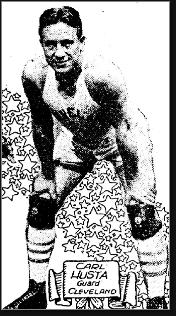
Sports: Basketball & Baseball
Born: April 8, 1902
Died: November 16, 1951
Town: Little Egg Harbor, New Jersey
Carl Lawrence Husta was born April 8, 1902 in Little Egg Harbor, NJ. Basketball became a popular spectator sport in South Jersey during the World War I era, and Carl distinguished himself as a top all-around player as a teenager with the Egg Harbor Regulars. He and his older brother, Mickey, shared the backcourt for the team. Hoops impresario Pop Morganweck spotted Carl and his brother and signed both to play with the Kingston Colonials of the New York State League, one of the game’s top pro circuits.
Kingston won the league championship in 1922–23, with Carl finishing third on the team in points behind Benny Borgmann and Charlie Powers. At 21, Carl was the youngest payer on the club. He was often compared to Nat Holman, who was in six years older. Holman redefined the guard position as a do-it-all leadership position on both offense and defense. Carl, who stood 5’11”, was following in his footsteps.

In 1925, the first bona fide attempts was made to form a national circuit, the American Basketball League. The Cleveland Rosenblooms—owned by department store magnate Max Rosenbloom— had been a Midwestern powerhouse for more than a decade, thanks to the hiring of former college stars. Rosenbloom stocked his ABL entry with some of the top pros in the country, including Carl, Nat Hickey, Dave Kerr and fellow New Jerseyan Honey Russell. Carl was the club’s number-three scorer as they cruised to the 1925–26 title and swept the Brooklyn Arcadians in the best-of-five championship series.
Carl played six seasons with Cleveland and won ABL championships again in 1929 and 1930. He was the only player to finish among the Top 10 scorers in the league in each of the ABL’s six seasons. After the ABL folded, he barnstormed with the Ofiginal Celtics and eventually returned to the Colonials for three seasons. In 1938–39, Carl served as player-coach of the Troy Haymakers. It was his final season as a pro.
Like many players of his era, Carl suited up for multiple teams at the same time. Among the New Jersey cities whose uniform he wore were Passaic, Perth Amboy, Bridgeton and Camden.
During the summer months, Carl played baseball for various semipro teams. At the tail end of the 1925 season, he was signed by Connie Mack as a utility infielder for the Philadelphia A’s. Carl saw action in six games, collected three singles and knocked in runs against the Browns and Yankees. He played full seasons in the Class-C Piedmont League in 1926, ’27, ’29 and ’30—batting over .300 with 15 homers in 1929 for the Henderson Bunnies. HIs baseball teammates called him “Sox.”
Unlike many pro athletes, Carl was smart with his money and was able to retire comfortably to Kingston, where he worked at an electrical plant. He enlisted in the army during World War II and returned to upstate New York after the war. He passed away from chronic myocarditis at age 49 in Kingston. Although the game had evolved dramatically in the decades after his playing days, he was still much admired when the Basketball Hall of Fame was created. There was a groundswell of support for his induction, but he was never enshrined.